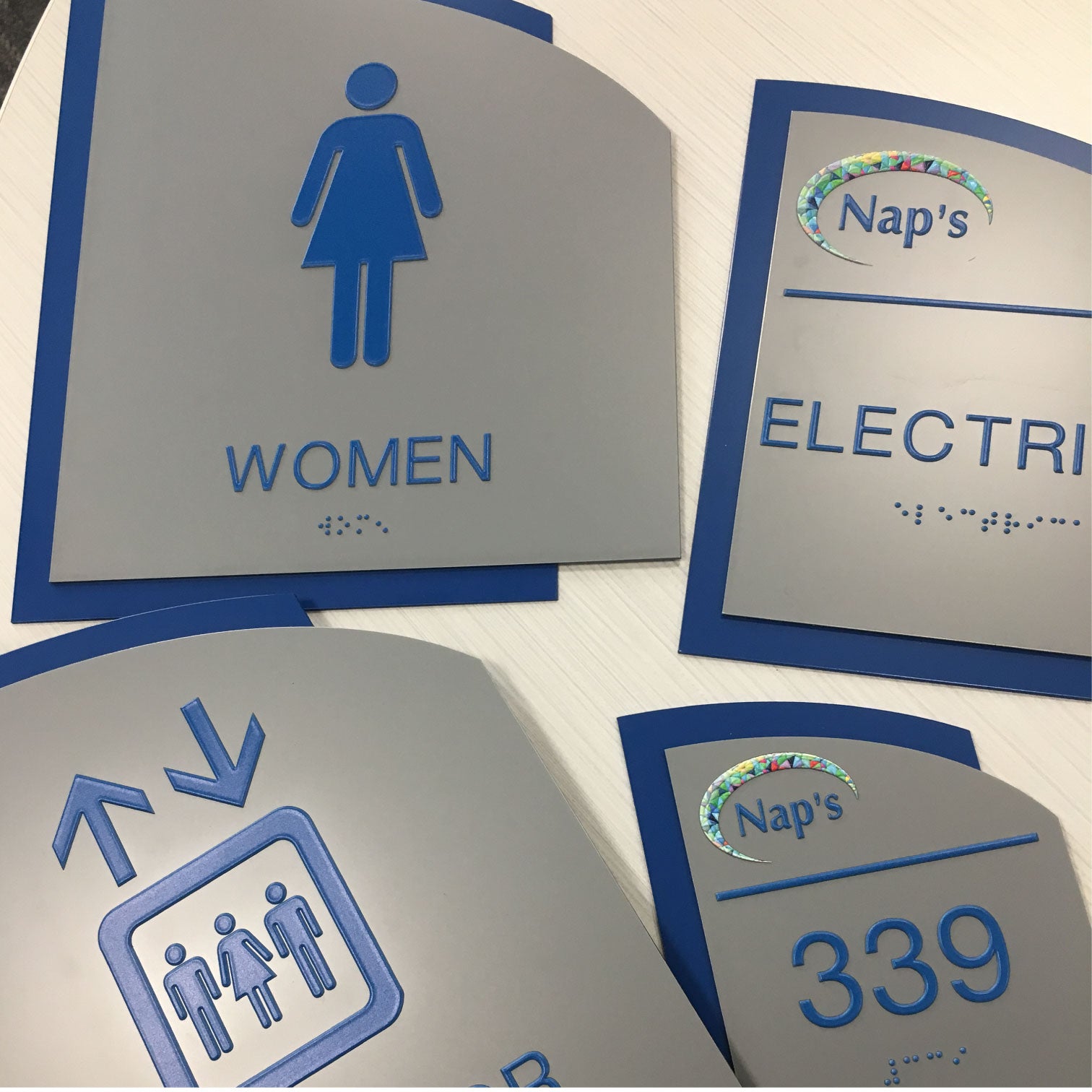Discover the Relevance of ADA Signs in Public Spaces
Wiki Article
Exploring the Trick Features of ADA Signs for Improved Availability
In the world of ease of access, ADA indications offer as silent yet powerful allies, guaranteeing that spaces are accessible and comprehensive for individuals with impairments. By integrating Braille and responsive elements, these indications damage barriers for the visually impaired, while high-contrast shade schemes and understandable font styles provide to varied visual requirements.Importance of ADA Compliance
Making certain conformity with the Americans with Disabilities Act (ADA) is crucial for cultivating inclusivity and equivalent accessibility in public areas and offices. The ADA, established in 1990, mandates that all public centers, companies, and transportation services accommodate individuals with disabilities, guaranteeing they take pleasure in the same legal rights and chances as others. Compliance with ADA criteria not only meets lawful obligations yet likewise improves an organization's reputation by demonstrating its dedication to variety and inclusivity.Among the vital elements of ADA compliance is the application of obtainable signs. ADA indicators are made to make certain that individuals with disabilities can easily navigate with spaces and buildings. These signs should abide by details guidelines regarding size, typeface, color contrast, and positioning to guarantee presence and readability for all. Correctly applied ADA signage assists remove barriers that people with specials needs usually run into, consequently promoting their self-reliance and confidence (ADA Signs).
Additionally, sticking to ADA regulations can alleviate the danger of lawful repercussions and possible fines. Organizations that stop working to abide by ADA standards might face charges or legal actions, which can be both economically difficult and destructive to their public photo. Thus, ADA conformity is important to cultivating a fair environment for every person.
Braille and Tactile Aspects
The incorporation of Braille and tactile components right into ADA signs personifies the concepts of accessibility and inclusivity. It is commonly placed underneath the matching text on signs to ensure that individuals can access the details without aesthetic support.Tactile elements extend past Braille and consist of increased symbols and characters. These components are developed to be discernible by touch, permitting individuals to identify area numbers, toilets, exits, and various other essential areas. The ADA establishes certain standards relating to the dimension, spacing, and positioning of these responsive elements to optimize readability and make certain consistency throughout different settings.

High-Contrast Color Design
High-contrast color pattern play a crucial role in enhancing the exposure and readability of ADA signs for people with aesthetic impairments. These systems are necessary as they make best use of the difference in light reflectance between text and history, making sure that signs are conveniently discernible, also from a range. The Americans with Disabilities Act (ADA) mandates making use of specific color contrasts to suit those with minimal vision, making it a crucial facet of conformity.The efficiency of high-contrast colors depends on their ability to stand apart in numerous lights conditions, consisting of dimly lit settings and areas with glow. Generally, dark message on a light history or light message on a dark history is used to attain optimum comparison. For circumstances, black message on a yellow or white history offers a stark visual distinction that helps in quick recognition and comprehension.

Legible Fonts and Text Dimension
When considering the style of ADA signs, the selection of readable fonts and ideal text dimension can not be overstated. The Americans with Disabilities Act (ADA) mandates that fonts need to be not italic and sans-serif, oblique, script, very attractive, or of unusual type.According to ADA guidelines, the minimal message height must be 5/8 inch, and it ought to enhance proportionally with seeing distance. Uniformity in message size adds to a cohesive visual experience, assisting individuals in browsing settings efficiently.
In addition, spacing in between lines and letters is important to clarity. Adequate spacing protects against characters from appearing crowded, improving readability. By adhering to these criteria, developers can significantly improve ease of access, making sure that signage offers its desired function for all people, no matter of their visual capacities.
Reliable Placement Techniques
Strategic placement of ADA signs is important for making the most of availability and making sure conformity with lawful criteria. ADA article source guidelines state click this that indications ought to be mounted at a height in between 48 to 60 inches from the ground to ensure they are within the line of view for both standing and seated people.In addition, indicators should be placed adjacent to the latch side of doors to permit very easy identification prior to entrance. Uniformity in indication positioning throughout a facility boosts predictability, decreasing complication and boosting general individual experience.

Conclusion
go to the website ADA indications play an important duty in promoting access by integrating attributes that deal with the demands of people with specials needs. These components collectively foster a comprehensive setting, underscoring the importance of ADA conformity in making sure equivalent accessibility for all.In the world of ease of access, ADA signs offer as quiet yet effective allies, guaranteeing that areas are inclusive and navigable for people with handicaps. The ADA, enacted in 1990, mandates that all public centers, employers, and transportation services accommodate individuals with handicaps, guaranteeing they appreciate the very same legal rights and chances as others. ADA Signs. ADA signs are designed to make sure that individuals with handicaps can quickly browse with areas and structures. ADA standards stipulate that indicators need to be installed at a height between 48 to 60 inches from the ground to ensure they are within the line of view for both standing and seated individuals.ADA signs play an important role in promoting availability by integrating attributes that attend to the needs of people with disabilities
Report this wiki page